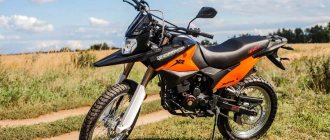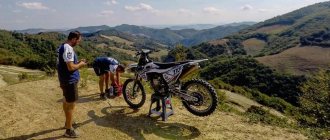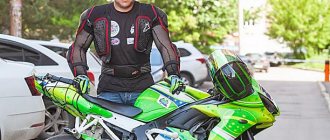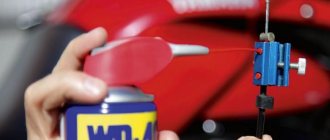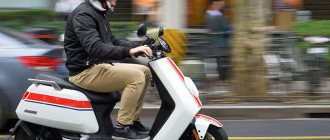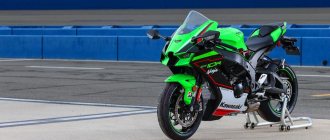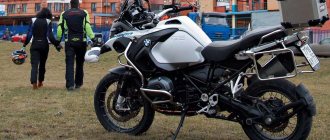The arrival of full spring has been delayed this year, and with it the opening of the motorcycle season. The warm weather stabilized only last weekend, so we went to a motorcycle service center to service the motorcycle and talk to an experienced mechanic about the nuances of maintaining the bike.
Spoiler: in a conversation with the master, a lot of interesting and little-known details emerged, and we also learned about one interesting development - an automatic chain lubricator with GPS tracking was invented in Belarus. However, first things first.
The key to success is proper preservation
It's been a long time since there was such a cold spring! I went for service on the morning of May 8, the temperature was about +4°C! I was frozen, but I made it to the service station.
We will service the M1NSK C4 250 with a mileage of 14,000 km. From experience in operating a variety of Chinese motorcycles: the C4 250 is the most reliable and high-quality. The brakes are atrocious, the engine does not require any attention, in general there were practically no breakdowns. Oil was leaking from under the valve cover - it was replaced under warranty. The pads were changed. The chain was “updated” at 14,000 km (the original Chinese one lasted up to this mileage!). That's all.
At the service we will fix some small things after a small fall on the side, clean the ignition switch contact group and bleed the rear brake. The most important thing is to use this bike as an example to show what needs to be done with a motorcycle after winter and how to properly look after it. For any motorcycle, not just M1NSK.
Oh yes, we forgot another breakdown. Somehow the starter relay got stuck. After opening it, moisture and rust were found inside. What was the reason? At first, the owner constantly washed this motorcycle in a high-pressure washer. Water got into the relay - everything inside was rusty.
“One of the most important tips is to wash your motorcycle as rarely and carefully as possible,” begins the story of Alexander, an instructor at the I.Ride motorcycle school and part-time motorcycle repairman with extensive experience . – Because of this, many problems arise. Water under pressure does not wash away heavy dirt on the frame, fork and chassis elements, but under pressure it drives it into the bearings and various joints. The same relays as this motorcycle. In all the cracks. Everything there is actively rusting and wearing out.
Bike storage is also important. If you preserve it correctly, then after winter you just need to brush off the dust and go. But in this case, the motorcycle was not stored properly, having stood outside under a cover for part of the winter, so a problem emerged with the ignition switch, and in some places, corrosion. Therefore, a rare and proper wash, high-quality preparation for winter storage, preferably in a warm garage, and everything will be fine with the motorcycle. These are two important points."
By the way, Alexander is exactly the person who jumped from a high mountain on an M1NSK X250 motorcycle in the video on our YouTube channel.
Visual inspection of the engine
We think that even those who are starting their first season know why a motorcycle needs an engine.
What you need to pay attention to:
- Presence of smudges
- The sound of the engine
Inspect the engine carefully. There should be no traces of oil or other technical liquids anywhere on it. First of all, look for fresh tracks. If the engine has them, the problem is with it or with any of the components located above it.
Looking ahead, let's say that upon completion of the visual inspection, you will need to start the motorcycle. Listen carefully to see if there are any extraneous sounds in the engine: knocking, clattering, etc. If there is the slightest sign of malfunction, turn off the motorcycle and contact a service center.
What do we do?
We'll talk about washing later, but first, let's raise the motorcycle. We will wash it later, because during the maintenance process it will only get dirty. What should a motorcyclist do when it gets warmer before his first ride?
To begin with, standard maintenance is changing the oil, oil and air filters.
“How often do you change the oil? On average, according to regulations, the oil in a motorcycle is changed every 5,000 kilometers,” continues Alexander. – In some motorcycles – once every 10,000. But I still recommend, regardless of the regulations, reducing the oil change period in a car to 10,000 kilometers, in a motorcycle - to 5,000. Still, the bike engine runs at higher speeds, it experiences more loads. In this particular motorcycle, according to regulations, the oil is changed every 3,000 kilometers. But you don’t need a lot of it, a little more than a liter, so frequent replacement is only a plus.
Of course, 4T motorcycle oil is not the cheapest. In terms of price and quality, Petronas is a good choice now. Not for the sake of advertising, but simply other oils that are unrealistically expensive. Another question: if the motorcycle has not traveled 5,000 kilometers during the season, does it need to change the oil once a year? It's better to change it. But if the bike is parked in a warm garage in the summer, it is doubtful that the oil will directly take over and oxidize. It’s also not worth stretching out the replacement over years if your two-wheeled friend doesn’t ride much. Also, do not forget to change the oil and air filters. I change it along with an oil change, all this is inexpensive, and the roads are dusty.”
It is important to check all bolts, especially on single cylinder Chinese motorcycles.
“They come to me and ask me to tighten all the connections. But you need to understand: in order to tighten the bolt, you must first unscrew it. And is it necessary to do this, especially on the engine? There is a saying, partly true: if something is working, don’t interfere with it, don’t interfere. In normal, non-Chinese motorcycles, everything is initially tightened in such a way that it will not unscrew on its own. Plus, thread glue is used.
It is important not to tighten the connections, but simply check them. In this motorcycle, for example, the clutch cable mount was loose. Levers often come loose, on any motorcycle. Just check if the bolts on the motorcycle are loose, that's all. And if you twist them, then put them on thread glue.”
The next thing we do consistently before the start of the season is lubricate the clutch and throttle cables. We disconnect the cables and put regular oil inside, 20-30 grams is enough. We develop the core by moving it inside the casing, after which we screw everything back.
But a motorcycle has many other rubbing parts. All this can be lubricated with regular chain lube. It is thick and holds up well. The main thing is to thoroughly wipe off the excess.
The brakes of the C4 250, although they slow down the motorcycle instantly, also require attention. The rear brake pedal became soft and the travel increased. Clearly there is some problem.
“Regulations for changing brake fluid are different everywhere. Some people change it once a year, some – once every two years, and some don’t change it at all. But the brake fluid needs to be changed periodically. In this case, it is noticeable that it has darkened, and this is from wear and tear. Also, in this motorcycle, due to long periods of inactivity, the rear caliper guide has rusted. The pedal became soft, the stroke increased. Therefore, we do maintenance on the caliper and change the brake fluid.”
We took it apart - the guide does not move at all, the pistons are dirty, and the cylinders are not particularly clean either.
We take everything apart, wash it, clean it and put it back together.
We change the brake fluid - now the brakes are in perfect order.
Checking the condition of the air filter
The air filter cleans the air entering the engine.
What you need to pay attention to:
Air filter condition.
Filters are disposable and serviceable. It is recommended to change disposable ones before the start of the season, regardless of the service life indicated by the manufacturer.
With serviced filters the situation is slightly different. They can be taken out, cleaned and soaked in special oil. With the help of such oil, the filter retains the smallest dust, and larger particles get stuck in the filter fabric. Proper maintenance of such a filter can extend its service life.
Important! Use only filters specified by the manufacturer. A lack of air-fuel mixture negatively affects engine performance. Oil impregnation increases the filter resistance, reducing the supply of oxygen.
To visually assess the condition of the air filter, open the ventilation duct and remove the filter. Assess its cleanliness and general condition. If there is dirt (and after the season there will definitely be dirt), clean the filter in accordance with the instructions included with it. If the filter is disposable, replace it.
Adhere to the following rules:
- Do not use gasoline for cleaning.
- Do not twist or squeeze the filter.
- Do not blow dry or expose to high temperatures.
- Do not use machine oil for impregnation.
Corrosive matters (and not only)
At the same time, we note that it is important to store the motorcycle in a dry room. He stood outside - condensation penetrated into all the cracks. For example, drops of water were noticed under the brake fluid reservoir cap.
The caliper mounting bolt looked like this. They also washed it, cleaned it, lubricated it, and put it back.
The exhaust pipe is covered in rust. Due to high temperatures, the paint burns and the metal begins to corrode.
This problem is common not only to the M1NSK, but to all motorcycles in principle. What to do? Nothing to do. For aesthetics, you can wrap the exhaust pipe with thermal tape. There are no other options.
Motorcycles do not drive in winter. As a rule, they do not rot like cars, but corrosion appears on them too. Therefore, you need to store your motorcycle properly and clean it thoroughly before storing it for the winter. If corrosion has appeared, you can use chemicals with corrosion preservatives - there is a wide choice of them. If the motorcycle is expensive, the element is repainted. For expensive motorcycles, there are detailing centers where bikes spend hours in order and polished like a copper kettle. But the service is not the cheapest.
We took out the contact group of the ignition switch - one of the contacts had oxidized. The lock was “glitchy”, the ignition turned on every other time, and a couple of times it disappeared right on the road, which is dangerous. We cleaned it with fine sandpaper, coated it with contact grease, and put everything back together. The problem has disappeared.
We also check the play in the wheels, like a car. Problems are already beginning in the rear suspension, you will need to come to replace the bearings.
Another operation is to drain gasoline from the carburetor sump.
“In general, if something is working, it’s better not to mess with it, especially the carburetor. But you need to periodically drain the dirt from the sump. This has never been done on this motorcycle, so it makes sense to perform such a simple operation. The main thing is not to forget to tighten the bolt back later, otherwise gasoline will spill out.”
Starting on the air
On ether, you can start the engine alone, but this method, often used in Siberia in frosts below 40 degrees, kills KrAZ vehicles in one season of operation. If it doesn’t help, then the problem is something else; diagnostics and, if necessary, repairs are required. This is done like this: remove the air filter cover (if you have a filter under the tank, lift the tank), spray a generous amount of ether directly onto the filter element (Starting Fluid, 100 rubles in any auto parts store), close the cover (put the tank in place, you don’t have to screw it on yet , the main thing is not to waste time until the ether evaporates). Now we start again with the choke pulled out. If the engine does not start after three or four times, then there is nothing to catch, you need to go to a service center. If you even sneeze, you can try repeating the procedure. And the smell... Be careful not to choke.
How to wash?
We'll tell you about the chain after washing the motorcycle, when it needs to be lubricated. For now, let’s talk about cleaning the bike itself.
“The motorcycle must be clean - it is both aesthetically pleasing and prevents the development of corrosion. But in hard-to-reach places a lot of dirt usually accumulates. Trying to knock it all down with a high-pressure washer with a powerful cutter means driving water along with dirt into the seals and bearings. Therefore, we take a cloth, a cleaner and wipe everything with our hands. Constantly washing your motorcycle at self-service car washes is harmful. It is necessary to wash it periodically, but it is better to knock off the dust from a distance and then wipe it with a cloth. Pressure washing negatively affects the durability of motorcycle parts and components.”
The most important thing is not to do as in the photo below.
In this way, we drive water and dirt into the bearings, thereby “killing” them. No need to bring the cutter close! On older motorcycles this can also remove the paint.
This is a quick way to wash a motorcycle. I wash from afar with water under pressure, knocking down dirt. Then we coat it with chemicals and let it work for five minutes. We also wash it off from afar. We blow out the remote controls with compressed air, if possible. Then wipe with a soft cloth - you're done.
First departure
After a long winter, you really want to turn off the gas and remind the city of yourself. We kindly ask you not to rush. Preparing for the season is important. Spend two to three days regaining the skills you lost over the winter.
- It would be a good idea to stop by the site and ride around there for a bit.
- Remember, at the beginning of the season the nights are still cold and the asphalt does not have time to warm up, the grip of the wheels on it is minimal.
- Do not make sudden maneuvers until the tires are warmed up.
During your first rides, try not to go far from home, carefully observing the behavior of the motorcycle. After completing the trip, check to see if there are any leaks of technical fluids. Checking additional modules (attachments: cases, holders for smartphones and accessories, etc.)
Once you have checked the technical condition of the motorcycle and performed pre-season maintenance, take a few more minutes and examine the condition of the additional equipment.
Check the fastening of the phone holder, navigator, case. Make sure the panniers are secure and easy to lock. If you installed various equipment yourself (additional light, cigarette lighter), check the connection points to the on-board electrical network.
What about the chain?
The most convenient and reliable cardan transmission in a motorcycle, but it is not suitable for off-road use and is quite cumbersome. There is a belt drive - it is ideal for city use. And you don’t need to service it, just drive and that’s it. But the belt itself is quite expensive and also extremely dislikes off-road driving.
Most often, motorcycles use a regular chain, sealed or sealless. It needs to be periodically tightened and lubricated every 300 km or after the next rain. Sometimes, as it gets dirty, you need to clean it with a brush and diesel fuel or kerosene - not the most pleasant experience. In general, the chain requires attention. But you can drive off-road with it, and the unit itself is relatively inexpensive (a DID chain, for example, costs about $100). What can you do to extend the life of the chain and save yourself from lubrication?
To do this, there are automatic chain lubricators that do this at certain intervals. But in Belarus they went further and made a “smart” chain lubricator. The first batch of the product is still being tested, which will be carried out at the I.Ride motorcycle school. The peculiarity of the lubricator is that it has a “brain”, which, based on data from GPS, calculates the distance traveled and acceleration. The greater the acceleration, the greater the load on the chain - more lubrication is needed. Everything is calculated automatically, the oil is supplied based on this data. Thanks to the device, you can at least double the life of the circuit.
There are two ways to lubricate a chain. Quick - hang the wheel, wipe off the remaining water after washing with a rag, spin the wheel and lubricate the chain as in the photo. Then we wipe off the excess and we’re good to go.
The second method is to lubricate each chain link long and hard. Slowly, but better.
“From experience, no matter how you lubricate the chain, it still hasn’t lasted longer than 10,000 kilometers,” says Alexander. – And now I generally ride on a cardan. Therefore, the best solution is to install an automatic lubricator and forget about the chain altogether. Because I still want to travel, and not dance around with a tambourine. And for travel, when you need to cover a long distance, this is generally the only right solution.”
Now the ignition
The ignition system, in the part that is accessible to the kettle for inspection and repair, consists only of spark plugs and a battery, so we’ll limit ourselves to that. The condition of the battery is the most important factor for trouble-free starting, so I recommend not neglecting it. A car battery, “lit” through the wires, will help, but will not give the same effect as a well-charged motorcycle battery of your own. Not to mention the fact that a battery that has self-discharged over the winter will not crank the engine, it will also not provide the necessary voltage to the “brains,” which as a result will refuse to work correctly and give a spark. So it’s better not to even try with a discharged battery.
Let me remind you that it is best to charge the battery with a current of 10% of the rated capacity for 10 hours, i.e. A battery with a capacity of 9 A/h is best charged with a current of 0.9 A for 10 hours. The recommended charging current is written on the battery cover, so it makes sense to look. The Moto.Ru Store has a special device for charging motorcycle batteries, everything is free, come and charge. It is better not to use car “automatic” chargers - they are designed for the capacity of a standard car battery (50 A/h), and when you connect a relatively weak motorcycle battery to them, they think that they have a very dead car battery in front of them, which they are trying to invigorate with mega-current.
Some batteries can be charged in accelerated mode for an hour with a current of half the capacity (for example, for a Yuasa battery with a capacity of 9 A/h it will be 5 A for an hour), but only if this is written directly on it. Almost all Yuasa batteries, standardly installed on Hondas, have this capability. When charging, by the way, do not forget to remove the caps of the cans (if they can be pulled out!!!). The same Yuasa are equipped with a special “tablet” that allows the released gas to pass through, but does not allow liquid to pass through.
Further, for a good starting current, the battery must have a good electrolyte density (this is if the battery is serviceable). To measure the density of the electrolyte, there are hydrometers, sold for 20 rubles in any auto parts store. The density of the charged battery should be 1.27, if not, then you need to add distilled water - it costs 10-15 rubles for 1.5 liters. Be careful with electrolyte - it can easily damage your clothes if you wipe your hands stained with it on your pants.
If the battery is weak (it seems to spin, but dies quickly), you can try to revive it with products like Electro Start or Amper Plus. Do not overdo it with the dosage - they are designed for car batteries. Pour liquid or powder into the holes of the cans (if the battery is maintenance-free, you will need to gain access to the holes by barbarously tearing off the very strip on which “maintenance-free” is written ;))).
Our verdict
Preparing the motorcycle for the season took about half a day, taking into account the fact that it had not been serviced for a long time and had been idle for a long time not only in winter, but also in summer, which is harmful for the equipment. A motorcycle needs to be ridden, it needs to be started and driven periodically. Maintenance is also important, even more important than car maintenance. Because in a car the body is covered by at least the body and airbags, but here there is none of that. Only you and the powerful bike under you, which must be in full working order. Fortunately, technology is not as complicated as cars, especially simple single-cylinder motorcycles, which are unpretentious in maintenance. The editors thank the I.Ride motorcycle school and Alexander personally for their assistance in preparing the material
The dream is closer than it seems. Motorcycles in the Automotive Business ad database
Starting from a pusher
The first method is well known to everyone without exception, but for the sake of completeness I will repeat it. You need at least two people to push, since one person is definitely not enough to start a more than 400 cc bike, unless, of course, it is standing on the top of Chomolungma. The choke must again be completely pulled out if the engine is cold. It is practically pointless to push-start a Japanese bike with a high compression ratio on a dirt road, especially if it is wet. I tried it myself, hey. For those completely ignorant, the procedure is as follows: the driver sits on the bike, puts it in second gear and holds the clutch lever depressed, while another pushes him to running speed. Don’t forget to turn on the ignition ;)) The critical thing is to “press” the bike at the moment when the driver releases the clutch lever and the engine is switched on in the power circuit. The driver must be prepared for the vehicle to start and rush forward. Then you urgently need to press the clutch lever and switch to neutral. It is not recommended to turn off the engine for 15 minutes so that it warms up and the battery is at least slightly charged.
Starting a cold motorcycle engine with a carburetor or injection.
We will talk about Japanese motorcycles or European motorcycles ; on Russian-made motorcycles the starting devices are very outdated; it no longer makes sense to describe the starting principle, and most motorcyclists in Russia still make the right choice in favor of Japanese motorcycles , which are distinguished by their reliability and workmanship.
Starting a carburetor or injection motorcycle engine.
If there is a rotary control on the fuel valve, the lever must be turned to the On or Res position. Next, you need to fully pull out the choke , which is also the enricher or in English “choke”; in the Russian manner, motorcyclists call it “choke” or “ check ” (if it is present, for example on modern motorcycles of 2004-2007, there is no enrichment as such, in The enrichment system itself, of course, remains, but the motorcycle electronically regulates the position of the damper).
And so, having pulled the enrichment lever all the way, by pressing and holding the “Start” button for several seconds on the right remote control (most often located on the right) - start the engine.
After the motorcycle engine starts working, it is necessary to maintain the engine speed within the range of no more than 2-3 thousand using a “choke-enricher”.
As the motorcycle engine warms up, we remove the choke. Twisting the throttle while the motorcycle engine is warming up is highly not recommended. The choke-enricher usually looks like a lever or pull button on the steering wheel. For example, on a Honda VFR 400 NC 30 motorcycle, the “choke” is located on the left side near the engine, behind the plastic. On the Honda CBR 400 motorcycle, the choke is located on the steering wheel. If the motorcycle engine , after rotating the starter for 3-5 seconds, does not start with the choke-enricher fully extended, you need to try again, but not earlier than after 1-2 minutes. If the motorcycle starter rotates vigorously, i.e. the starter has enough voltage received from the motorcycle battery , but the engine still cannot be started, you need to stop trying, wait 5 minutes and try again. Under no circumstances should you try to start the motorcycle engine by constantly holding the starter button; such handling can lead to failure of the starter components and complete discharge of the motorcycle battery . If the starter rotation is weak from the very beginning, you need to recharge the motorcycle battery with a special charger and try to start the engine again.
Tips for replacing spark plugs
Many bikers have problems with thread tightening - experienced motorcyclists know very well how many problems this can cause.
You can simply break the thread or, in the worst case, break the candle altogether. You will have to spend a lot of time cutting a new threaded connection or removing a broken part.
Advice! Buy products with rubber bands or magnets - according to statistics, in 99% of situations, they will help avoid damage to the ceramics on the spark plug.
A driver, or simply a ratchet key, needs to be purchased or borrowed. This tool will help you avoid over-tightening the spark plug and breaking its thread.
The second, and no less necessary tool is a feeler gauge designed to measure the spark plug gap.
In the service manual for the motorcycle (a book that is issued when purchasing a bike with all its technical characteristics and repair rules), you can easily find all the necessary numbers, including the clearance level.
A detailed overview of technical characteristics and reviews of the Yamaha YZF R6, from the Japanese manufacturer.
A brief overview, estimated prices, and technical characteristics of the Honda CBR600RR motorcycle.
Motorcycle control. Basic moments
In order to ride a motorcycle safely, you first need to learn how to sit on it correctly. Typically, this is done by adjusting the steering wheel so that the body leans slightly forward and the knees squeeze the fuel tank. Despite the fact that it seems more correct, sitting with a straight back is unsafe due to the unevenness of the road.
It is better for novice motorcycle drivers to start driving without starting the engine and choose an open area to accelerate. In order to start moving you need:
- Press the clutch lever;
- Activate transfer;
- Turn the throttle control, slightly release the clutch lever and add gas.
During acceleration training, it is recommended to master hill acceleration as a last resort. Learn to accelerate gradually, increasingly reducing clutch slip.
Sit on the motorcycle so that your right foot is planted on the ground while your left foot remains free to change gears. Then determine the clutch engagement point; this is done by slowly lowering the lever. You will feel the moment when the bike is ready to accelerate, and next time lower the lever to that point.
Now is the time to turn up the throttle by a third and, as the bike starts to move, slowly release the clutch. Now you can speed up and enjoy the ride.
Switching gears
Up is a high gear, down is a lower gear.
- Shift into top gear, reduce the speed, thereby lowering the engine speed, and depress the clutch, then engage another gear and release pressure on the clutch. Immediately add gas and increase engine speed. When changing gears, the cycle repeats.
- To shift down, you first need to slow down, press the clutch, engage a lower gear and add gas again. If desired, the motorcycle can even be stopped before switching.
To stop, you need to gradually slow down, shifting gears to first, squeezing the clutch. Use the rear brake, but don't think that using it is enough. Start stopping there, then move to the front
It is also important to calculate the braking so that the braking distance is not too long.
Some safety measures when riding a motorcycle are simply necessary:
- Don't drive. Driving slowly will allow you to become more familiar with the controls.
- Train in large, uninhabited areas.
- When entering a busy highway, be aware of other traffic.
- It is better not to drive in dangerous weather.
- Keep your distance from cars ahead.
Bringing the bike out of hibernation
The very first thing you want to do is start a stalled bike and listen to the rumbling of such a familiar engine. But doing this is strictly not recommended.
If you are an experienced motorcyclist, you have probably removed the battery from your motorcycle. All you have to do is check the voltage, charge the battery if necessary and attach the terminals to it, having previously secured it.
If you did not remove the battery and it has oxidized, then everything will be somewhat more complicated. If it is impossible to charge it, you will have to purchase a new battery, which can hit the pocket of an ordinary citizen (the cost of the battery is 1000-5000 rubles).
Among the highest quality and most reliable models are batteries from Yuasa and Kyoto.
The stylish, modern and rather aggressive design of the Stels 600 Benelli motorcycle makes a pleasant impression.
The main characteristics of a women's two-piece motorcycle suit, what kind of motorcycle equipment there is.
Photo gallery
We hope this article was quite useful and informative for you, and now you can easily prepare your “iron horse” for the new season. In conclusion, we offer a small photo selection.
